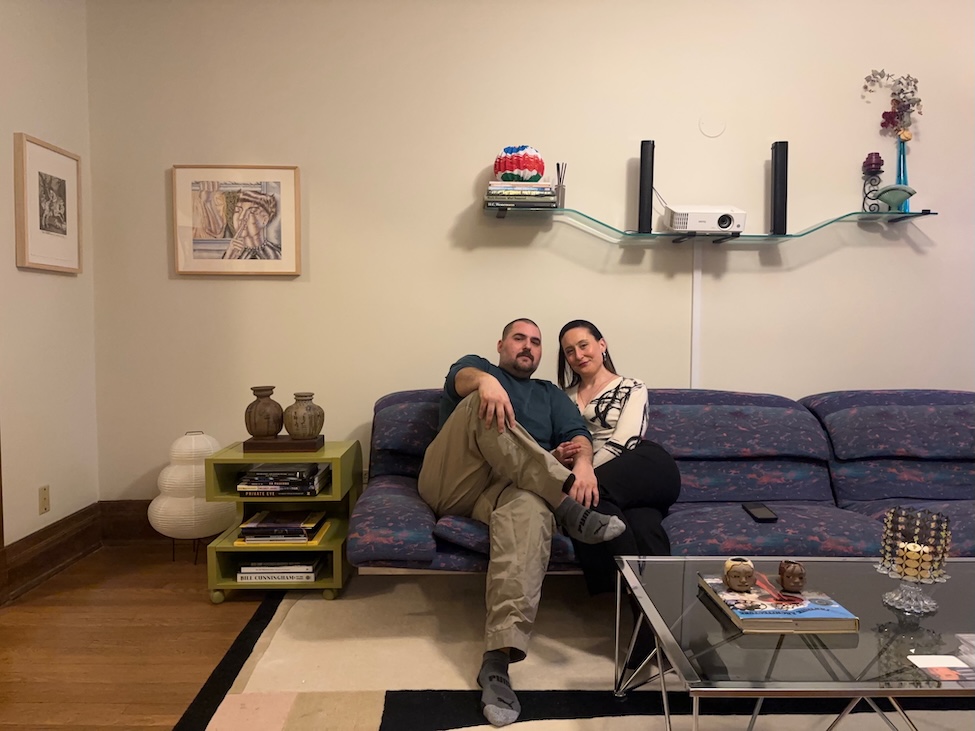Nurturing a Garden of Art: Michelle Edwards Tends to Her Collection

*This interview appears in CGN's fall 2024 magazine. To subscribe to the print edition click here.*
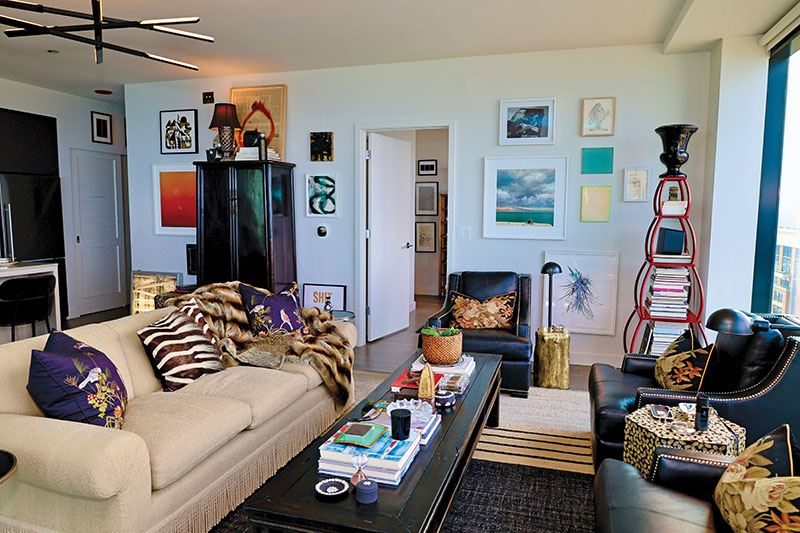
By BIANCA BOVA
“The place that art holds is sacred ground,” Michelle Edwards tells me. An established collector, fashion icon to those in the know, cultural patron, and–more recently–a realtor, Edwards’ reverential attitude towards art, if not life itself, is immediately discernible upon entering her home. Seated in her living room, surrounded by sweeping 47th floor views that look north over Grant Park and east out onto Lake Michigan, there is a serenity to the space, despite the fact that its entirety is densely arrayed with objects of all modalities. The predominant feature is, of course, the art collection, alongside which can be found selections of transferware, Wedgewood, and silver service pieces. The furnishings are lush, and thoughtfully selected. In less careful hands, the aggregate of it might overwhelm, but here, to the contrary, Edwards has created an oasis. She concedes to having had some help, noting, “I have for many years worked with Patrick DiMichele on my spaces. I won’t–can’t–live in an environment he has not done.”
*
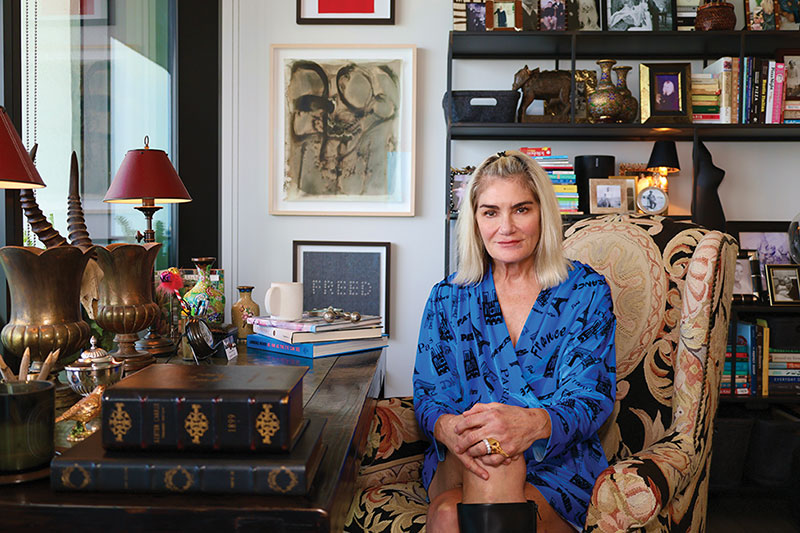
Edwards is not a lifelong art collector, or (to my surprise) even a lifelong art enthusiast. Her first love was fashion, with deep roots in the storied Oak Street boutique Ultimo.
“During high school I was a waitress at the Oak Room in Marshall Fields in the Oak Brook Mall, and I would save my tips, then I would go into the city, to Ultimo, and buy stuff on sale. I just loved magazines, French Vogue was my favorite. And I knew that Ultimo had Norma Kamali and they had Thierry Mugler, so I would go there,” she tells me, “When I got out of college, I was trying to figure out what I would do, and I interviewed across all these different jobs. Then I went down to Ultimo one day and they just hired me. You weren’t allowed to talk to customers for, like, six months. It was really this apprentice program. By the time I left, I ran the whole thing: men’s department, women’s department, all of it. I do have a tendency to end up running the show, whatever I do.”
“You have to understand that it was the equivalent of carrier pigeons compared to online shopping today. The access just wasn’t the same. There were really only four or five seminal boutiques in the world at that time, of which Ultimo was one. You relied on these boutiques for taste and for the edit. If it wasn’t in those stores, you didn’t need to have it, was the feeling.”
“I can’t garden, I’m not a gardener. So this is my garden. The amount of time that I spend interacting with the art–and everything in my home–it brings me so much joy. I stop and look at it. I spend time with different pieces. I’m tending my garden.”
– Michelle Edwards
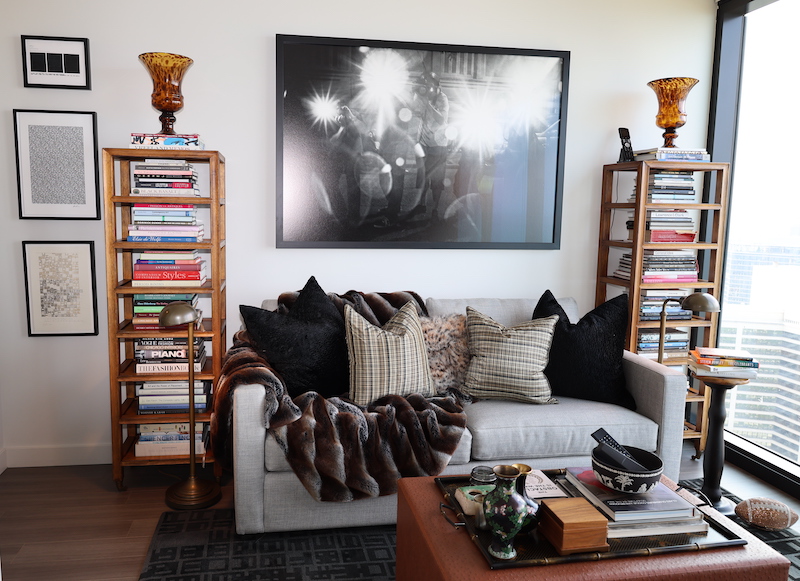
It was through her years at the boutique, from 1984 to 1999, that Edwards came into contact with the art world.
“When Art Chicago came around, it was a big deal at the boutique. It was the art crowd that traveled globally, and of course, they were shoppers. Everyone would come through that weekend.”
When Edwards herself visited Art Chicago in the late 1980’s she acquired her first piece of art, a small painting by the English artist John Virtue. It still has pride of place in her home.
“It was my first time ever at an art fair. I was with Lynn Sable, who was from Ultimo, and her brother is the art dealer Sean Kelly. He was there, and he was very passionate about his goal to have a gallery. And I don’t know–it was just infectious, it was so exciting. And this John Virtue, I just loved it.”
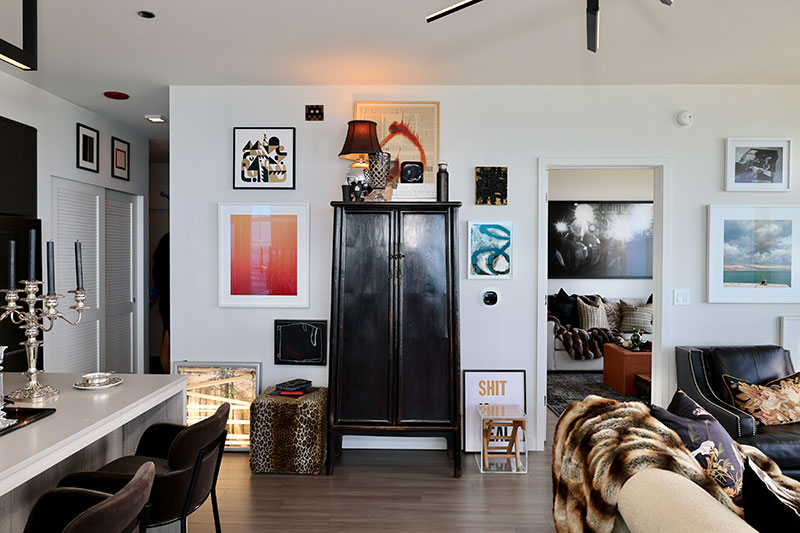
Despite this initial acquisition, buying work at fairs didn’t become a habit for Edwards, who still prefers a quieter approach.
“When it comes to collecting, I’m not an art fair girl,” she admits, “I like to go for the excitement, the community. That’s fun, but I can’t do: big, little, far, near, color, everything all at once. I get a headache. That’s why I love the gallery experience. I love a curated little show. I love a conversation.”
In fact, the acquisition of the Virtue did not give immediate way to collecting as a practice, or sustained participation in the art world. It wasn’t until the late 1990’s, after leaving Ultimo and being introduced to the Society for Contemporary Art (SCA) at the Art Institute of Chicago that her involvement became a more serious and intentional pursuit.
“I had a very good friend who is active in the art world globally, who used to be in Chicago, but has since moved to Los Angeles. She knew the SCA and she said, ‘I want you to join this group because they’re really good.’ When I joined, I did not like contemporary art. I did not understand contemporary art. I thought, ‘My dog can do that, my child can do that.’ I just didn’t understand it. But through attending lectures and realizing how unbelievably highly educated these artists are, and how thoughtful the work is–even if it’s work I don’t respond to–just to hear their story is so special to me. I started to go once a month, then I went to literally everything. At first, I didn’t talk to anybody. It took me a really long time to even decide to go to a dinner. I was hooked though. The first talk I went to was Gaylen Gerber, who of course spoke about [the color] gray. I remember going home and trying to tell people about this brilliant lecture, how thought provoking it was. I always feel bigger, better, fuller, richer for having heard someone speak about their work.” Her involvement quickly deepened as she joined the organization’s board of directors.
“Eventually they started to notice that I was attending with regularity. I believe it was Jay Dandy who called me then and said he’d like me to be on the board. And I said, ‘Well, what do I have to do?’ And he said, ‘Oh, you might have to make a batch of cookies or something like that.’ So, you know, a four year presidency term, four fundraising benefits, I don’t know how many years as secretary, three years as the acquisition chair, and over 20 years in total on the board later, I still haven’t made a batch of cookies. But it did change my life.”

As her long tenure on the SCA’s board comes to a close, Edwards continues to find new opportunities to support other institutions in the city, including the Museum of Contemporary Photography (MoCP), with whom she has recently become involved.
“I appreciate the accessibility of [MoCP Director] Natasha Egan. The ability to just speak to her, and that she just is this endless stream of brilliance, but so accessible. It’s really magic. It’s still a small institution, and it would be really fun to see them grow.” she adds.
As much as Edwards’ art collection has been led by her relationships with artists, dealers, and curators, it has also been informed by the spaces that have housed it. For years, she resided in the Kenwood neighborhood, in a historic home designed by famed Chicago architect Howard Van Doren Shaw, a leader in the American Craftsman movement. Built in 1904, the 10,000 square foot English country-style house sits on three quarters of an acre.
“It was a very experiential house,” Edwards tells me, “Living in Kenwood, too–it’s the cradle of art intellects in Chicago in some ways, and that was in the air. I loved that experience, but this–this apartment–this is where I belong. I see the collection differently now, because I can literally see it. There’s daylight. The light is different in the morning than it is in the evening. The light is different in the summer than it is in the winter. So the work also changes, in a way it just didn’t in a dark, brick and limestone house.”
As for the decision to also move the antiques into the new, more modern space, Edwards says with a shrug, “I didn’t think twice. There’s just that richness to it. I can’t live without this layer of richness. I think there’s this rogue gene I have, it’s the only way I can explain it.”
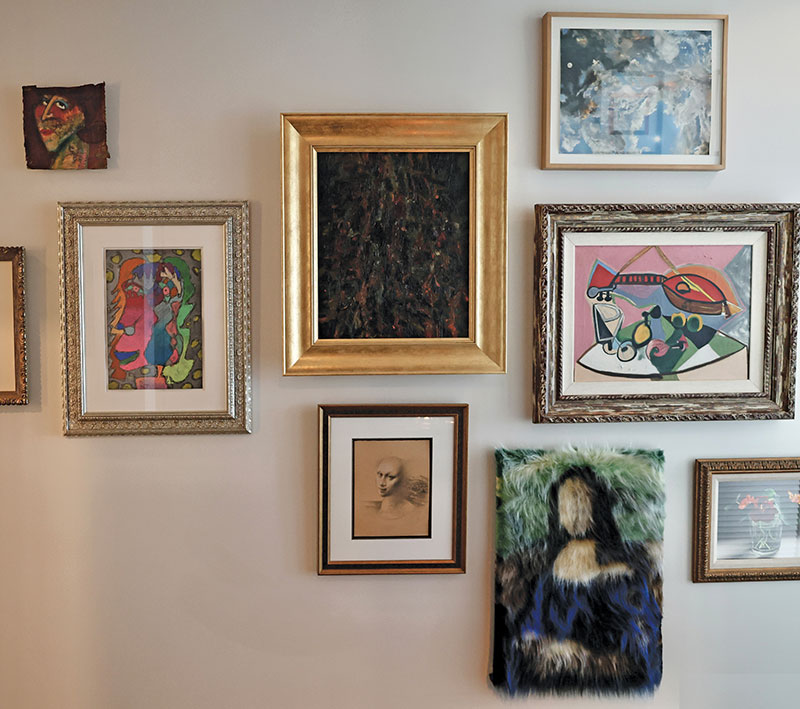
She points to several objects arranged on the coffee table between us, “This is my grandmother’s Bible. These were my great-grandfather’s buttons from his war jersey. Here are railroad spikes from when the SCA toured the 606. There really isn’t anything in this entire apartment–in my entire collecting existence–that there wasn’t some experience that it ties back to. A conversation, whether it was with the artist or with a gallerist, an event or a trip, or a memory of some kind.”
Though her collection in some ways feels like an encyclopedic look at Chicago’s art scene in the past 30 years, there is a distinctive eye guiding it that mirrors the discerning eclecticism evident in all that Edwards involves herself with. Works by everyone from Laura Letinsky, Nathaniel Robinson, Jason Lazarus, Aron Gent, and Jenny Shanahan, to Judy Ledgerwood, Tony Tasset, Cowboy, Robert Brown Jr., and the Loyola Condenser may be found, alongside the occasional work by Lenny Kravitz or Ken Fandell.
“I’ve never been a “checklist collector”–’Oh, I’ve got one of those, I got one of these, two of these’–those collectors working their way up the ladder hoping that they then get access to better stuff. I just don’t work like that,” she tells me, continuing, “And I’m not an impulse buyer. I have to go home and see how I feel about it in the morning. What I now have, what has developed over time, is just absolute confidence in what I collect. Plenty of works have come from galleries or from auctions, but I also have, for instance, a painting that I acquired off of Instagram, which was painted by a monkey. I love that monkey, I love the painting. I have a big, furry version of the Mona Lisa. I love the Mona Lisa, I have a real thing about the Mona Lisa, and I am also a fan of Sylvie Fleury’s fur paintings, so when I saw this, I thought–well, I just have to have it.”
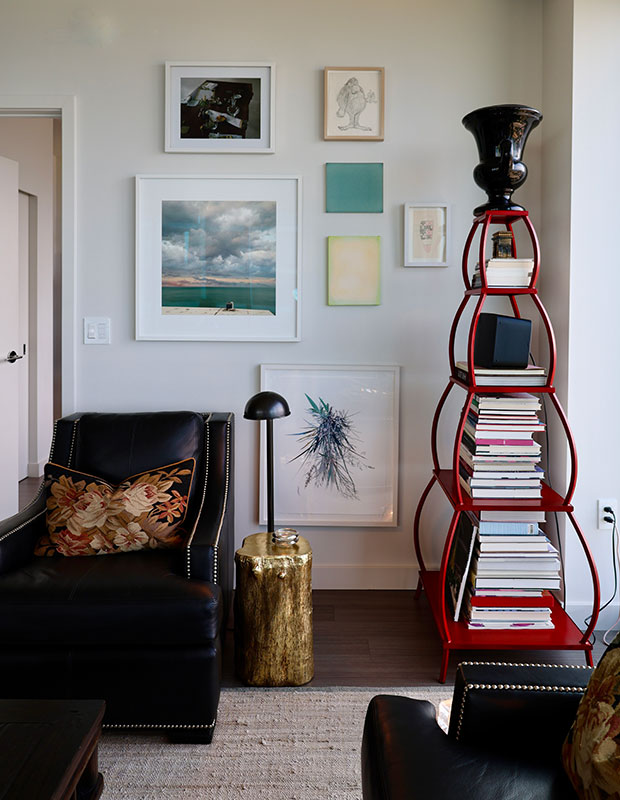
This nonhierarchical attitude is typical of Edwards, who acknowledges, “It’s paralleled by how I orient my wardrobe. People assume everything I wear is something, but it may not be. I have a jacket everyone raves over that looks couture, but it is, in fact, a Zara swimsuit cover up. Same principle as art. It’s confidence in what you have. It’s the eye.”
Whether it is her eye, her confidence, or, as she puts it, her “rogue gene” that acts as a guiding principle, Edwards can be counted on to bring the full impact of her experience to all that she does.
“Now I’m engaged with the real estate thing. A year and half ago I went to work with @properties Christie’s International Real Estate. The thing is, I’ve lived in a Lincoln Park studio, and a Bucktown bungalow. I lived in a greystone in Wicker Park and in a significant Kenwood country house mansion. Now here I am in a contemporary highrise on the lakefront. I’ve been in so many properties. I know why apartments work, and why houses work, and I know why they don’t work. It’s not unrelated to the way I understand fashion, or the way I understand collecting art.
I love to tend the flock, and I really enjoy guiding my people through incredibly emotional purchases, as with the passage of life that comes with finding a home,” she says.
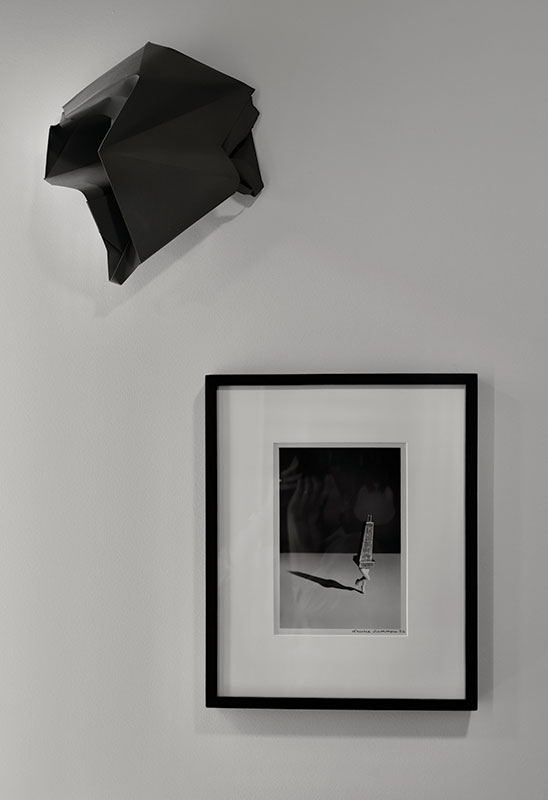
It is in Edwards’ own home that this ethos is exemplified, even celebrated. To move through its rooms is to be engaged, again and again, not just by the artwork, or by the furnishings, but by the stories that they each plainly tell. Great art and beautiful homes may be hallmarks of metropolitan life, but far fewer and farther between are such earnestly intentional collections, and striking, deeply personal domestic spaces as the ones Edwards has devoted herself to cultivating.
“I can’t garden, I’m not a gardener. So this is my garden,” She says, “The amount of time that I spend interacting with the art–and everything in my home–it brings me so much joy. I stop and look at it. I spend time with different pieces. I’m tending my garden.”
#
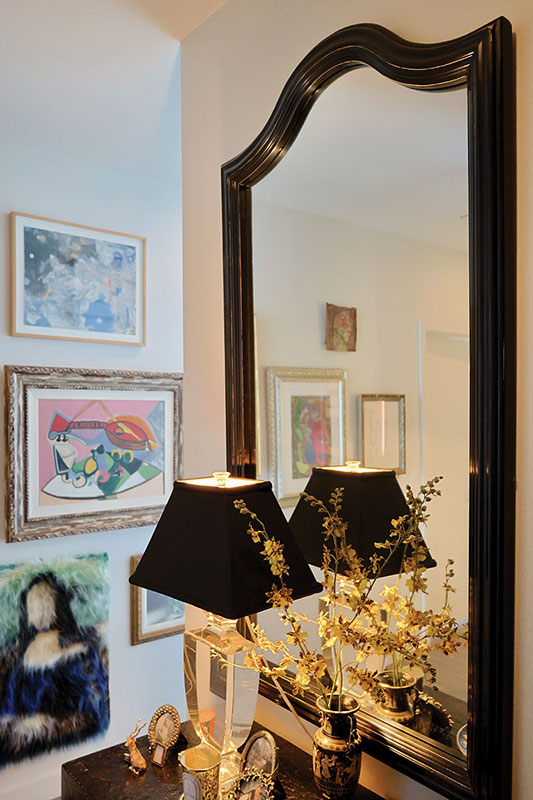
This interview is featured in CGN's fall 2024 magazine. To receive a print copy please click here to subscribe.
